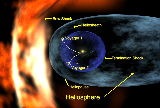Year 1 Report
A copy of the Year 1 Report handed in on 22 October 2007.
Project Outline
This project aims to contribute to understanding of the mechanisms by which particles are accelerated to high energies at collisionless supercritical shocks. Collisionless shocks are capable of pre-accelerating particles locally to suprathermal energies, providing a seed population for the Fermi acceleration of cosmic rays.
There are also mechanisms such as 'shock surfing' which potentially can accelerate particles to high energies at the shock itself. This project involves performing kinetic (PIC) simulations of supercritical shocks in order to study local particle acceleration. Issues to be addressed include the effect of heavy ions in the background population and the effect of recently discovered time dependence in the shock solutions. The results will be comparable with (i) other recent simulations (ii) Chandra observations of 'young' SNRs (iii) Voyager and remote observations of the heliospheric terminations shock and (iv) CLUSTER and other in-situ observations of the earth's bow shock.
Key Texts
- Krall N A and Trivelpiece A W: 1986, Principles of Plasma Physics, San Francisco, Inc.
- Birdsall C K and Langdon A B: 2000, Plasma Physics via Computer Simulation, Institute of Physics Publishing.
- Schwartz S J: 1985, Solar Wind and the Earth's Bow Shock in 'Solar System Magnetic Fields' Chapter 8, Edited by Priest, E.R., D.Reidel Publishing Company.
- Chapman S C, Lee R E and Dendy R O: 2005, Perpendicular Shock Reformation and Ion Acceleration, Space Science Reviews 121, 5-19.
- Bale S D et al.: 2005, Quasi-Perpendicular Shock Structure and Processes, Space Science Reviews 118, 161-203.
- Landau L D and Lifshitz E M: 1980, Course in Theoretical Physics, Volume 5, 3rd Ed. Part 1, Statistical Physics, Pergamon International Library.
Initial Tasks
- October - December:
-
- Run existing electrostatic code and develop diagnostics.
- Understand normalisation.
- Compare linear theory to simulations to check fastest growing mode.
- Ion-ring beam instability problem.
- January - March:
-
- boundary conditions
- shock following
- multi-species plasmas
Six-Month Milestones
- Solve 1D shock problem.
- Quasi-perpendicular shock in 3D electromagnetic PIC code.
Taught Courses
- Advanced Electrodynamics (1st semester).
- High Performance Computing in Physics - counts as two modules (1st semester).
- Advanced Data Analysis (2nd semester).
- Relativity and Electrodynamics (1st semester, year 2).

